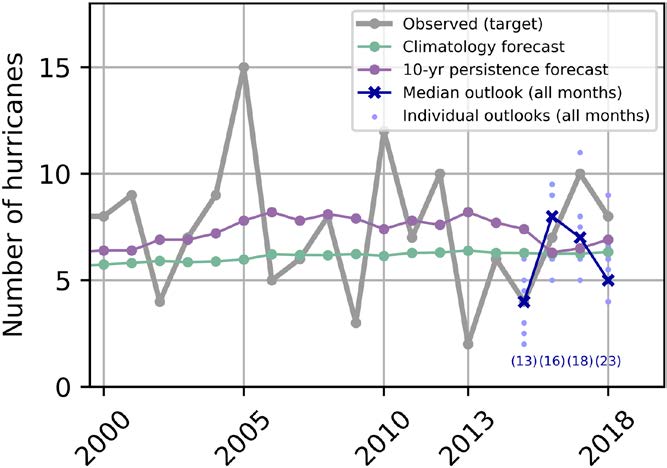Caron, L.-P., F. Massonet, P. J. Klotzbach, T. J. Philp, J. Stroeve, : Making Seasonal Outlooks of Arctic Sea Ice and Atlantic Hurricanes Valuable—Not Just Skillful. Bulletin of the American Meteorological Society, 101, E36-E42 , https://doi.org/10.1175/BAMS-D-18-0314.1
Key Points
Abstract
No abstract.
Key Figure
FIG. 1. Forecasts of North Atlantic basinwide hurricane number and verification data. The observed number of hurricanes for each season is shown in gray (Landsea and Franklin 2013). The light blue dots are all of the latest indi-vidual hurricane outlooks collected since 2015 (one dot per group). The dark blue line is the median of those outlooks. The green and purple lines are two benchmark forecasts - the climatology forecast is defined as the average of all hurricane counts from 1969 to the current year minus one (green), and the 10-yr persistence forecast is defined as the average of all hurricane counts from the 10 preceding years (purple). The numbers along the x axis indicate the number of forecast that have been submitted for a given year for that particular variable.
Acknowledgments
We would like to acknowledge the participation of the numerous forecasting organizations that submit their forecasts to both platforms on a regular basis, without whose support neither projects would be possible. LPC and PJK would like to acknowledge the support of XL Catlin (now AXA XL). FM is a F.R.S.–FNRS Research Associate. PJK would also like to acknowledge support from the G. Unger Vetlesen Foundation. JS acknowledges the support of NE/R017123/1 [NSFGEO-NERC Advancing Predictability of Sea Ice, Phase 2 of the Sea Ice Prediction Network (SIPN2)]. Finally, we are grateful to three anonymous reviewers who provided us with helpful comments.
